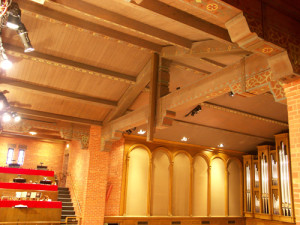Tannoy QFlex And VLS Column Line Array Loudspeakers Update University Christian Church

Texas Christian University in Fort Worth, Texas, has a new sound reinforcement system with Tannoy column line array loudspeakers.
University Christian Church (UCC), located on the campus of Texas Christian University in Fort Worth, Texas, recently upgraded its sound reinforcement system with Tannoy column line array loudspeakers.
Curt Taipale, owner of Taipale Media Systems (TMS), headquartered in Allen, Texas was tasked with designing the new system. He worked closely with SAV, a Plano-based system integration company that handled the installation.
“The existing sound reinforcement system was more than 20 years old,” explains Taipale. “I worked alongside Media & Technical Coordinator Jack Stewart to nurse it along for a time but it soon became clear that we needed to make an upgrade.”
The traditional cruciform design of the sanctuary has seating in the main sanctuary along with upper and lower seating in side transept areas. The last pew on the main floor is 120 feet from the main loudspeaker location, with balcony seating that extends back another 20 feet. A beautiful organ supports the choir – both are positioned behind the altar.
The most logical place to put the main loudspeaker was on the truss directly over the chancel, upstage of the pulpit location.
“We needed great pattern control from the main loudspeaker,” Taipale adds. “That meant choosing a very large format horn – which would be unsightly – or some type of line array. I chose a Tannoy QFlex 48 column line array loudspeaker.”
Taipale arranged a demonstration of a Tannoy QFlex 40 in the sanctuary of UCC in order for the church project team to experience his recommendation first hand. Graham Hendry, VP of Tannoy’s Applications Engineering and Support (AET) division, was on site to tune the system and answer any questions.
“The uninitiated tend not to believe me when I tell them that one tall, skinny column of loudspeakers can provide even sound coverage to listeners seated in the front as well as 140 feet away,” Taipale says. “The eyebrows really start to raise when I tell them that we can mount such a column vertically against the architectural truss and “steer” the sound energy down onto the listeners.”
The self-powered QFlex 48 is the largest discrete column array in the QFlex series. It consists of four connected modules for a total of sixteen 4-inch LF, sixteen 3-inch LF, and sixteen 1-inch HF drivers, each with its own discrete channel of amplification and integrated DSP (totaling 48 channels).
It is designed for use as a standalone self-powered column array device for both spoken word and full-range musical applications where high intelligibility and minimal visual impact are driving concerns.
Once the project team gave the approval, Taipale built the acoustical model using EASE software. In order to minimize how far the QFlex 48 protruded below the truss, it had to be raised as high as possible. As a result, the next truss out in front of the QFlex 48 blocked the HF section for listeners seated in the last six pews on the main floor. Taipale resolved that issue with the placement of a single Tannoy VLS 15 loudspeaker on a nearby truss that was aimed to cover those last few rows.
“In fact, we used a total of fourteen Tannoy VLS 15s in the project,” Taipale continues. “Most of them cover the lower and upper side transept seating areas with two more to cover the choir behind the pulpit and another covers the balcony at the back of the sanctuary.”
The VLS 15 is a passive column array loudspeaker loaded with seven 3.5-inch LF transducers mounted in vertical array with a group of densely spaced eight 1-inch HF transducers. The HF transducers are mounted co-axially over a section of the LF in an intuitively engineered, super-imposed chassis.
VLS Series is the first Tannoy product to incorporate FAST™ (Focused Asymmetrical Shaping Technology) which delivers unique acoustic performance benefits including asymmetrical vertical dispersion, gently shaping the coverage towards the lower quadrant of the vertical axis.
After the first system was deployed the church membership seemed in complete agreement – the system sounded terrific.
“The project team, church leaders and church membership were beyond happy,” concludes Taipale. “They had not heard services so clearly in quite some time.”




